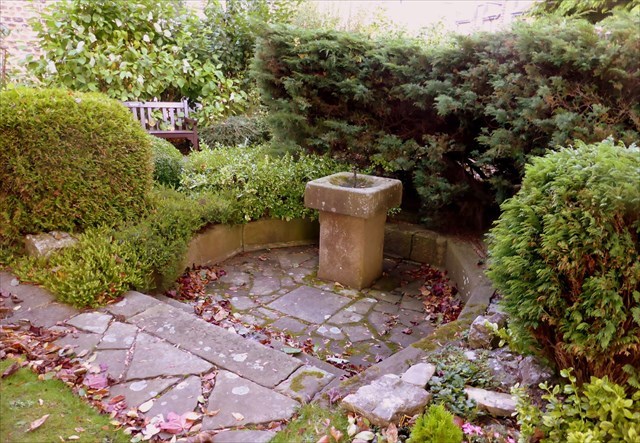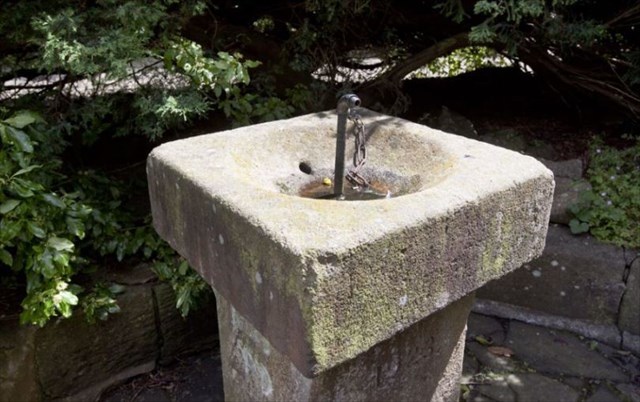Canker Well - Magic Waters No More

The cache, a camo-taped screw-topped micro sample tube, is hidden behind this historical feature located in a small garden. Santos L Helper's cache GC6512B Canker Well was also hidden (31/5/14) at this location before being archived 26/8/16 after some 100 finds.
Canker Well - also called Pollard Well in the past - was one of several chalybeate springs in the area and indeed around the country (ie. natural mineral springs rich in iron salts) which were regarded as being beneficial to health. Such wells often exhibit orange-brown staining of the stone due to evaporation of the ferruginous waters leaving deposits of the dissolved iron salts.
 The waters were either drunk in copious quantities or freely applied externally. After c1980, following residential development, the spring dried up. The stone-carved bath dated 1844 near the well was brought from the Shrine which was formerly part of Ben Rhydding Hydro. It bears a dedication to Vincent Priessnitz who established the principles of hydropathy (the utilisation of water in medical therapies) and who inspired Leeds merchant Hamer Stansfield to establish Ben Rhydding Hydro on land about a mile east of Ilkley - now occupied by Ilkley Golf Club.
The waters were either drunk in copious quantities or freely applied externally. After c1980, following residential development, the spring dried up. The stone-carved bath dated 1844 near the well was brought from the Shrine which was formerly part of Ben Rhydding Hydro. It bears a dedication to Vincent Priessnitz who established the principles of hydropathy (the utilisation of water in medical therapies) and who inspired Leeds merchant Hamer Stansfield to establish Ben Rhydding Hydro on land about a mile east of Ilkley - now occupied by Ilkley Golf Club.
Early in the 17th century, chalybeate water was said to have health-giving properties and many people have promoted its qualities. Dudley North, 3rd Baron North discovered the chalybeate spring at Tunbridge Wells in 1606. His physician claimed that the waters could cure: 'the colic, the melancholy, and the vapours; it made the lean fat, the fat lean; it killed flat worms in the belly, loosened the clammy humours of the body, and dried the over-moist brain.'
He also apparently said, in verse:
"These waters youth in age renew, Strength to the weak and sickly add
Give the pale cheek a rosy hue, And cheerful spirits to the sad."
John Radcliffe (1652–1714) discusses the benefits of various mineral waters in the chapter entitled 'Of Chalybeat Waters' in his book 'Dr. Radcliffe's practical dispensatory : containing a complete body of prescriptions, fitted for all diseases, internal and external, digested under proper heads'.
In June 2014 the well dried up for the first time in its 408 year history.
Anthony Relhan (ca. 1715–1776), promoted the drinking of mineral waters and particularly water from the chalybeate spring in St Anne's Well Gardens, Hove and published 'A Short  History of Brighthelmstone; with Remarks on its Air, an Analysis of its Waters, Particularly of an uncommon Mineral one, long discovered, though but lately used' in 1761. This led to a substantial increase in public interest in drinking mineral water. The town of Enfield, New Hampshire, even changed its name temporarily to Relhan because of the profound public interest in this form of therapy.
History of Brighthelmstone; with Remarks on its Air, an Analysis of its Waters, Particularly of an uncommon Mineral one, long discovered, though but lately used' in 1761. This led to a substantial increase in public interest in drinking mineral water. The town of Enfield, New Hampshire, even changed its name temporarily to Relhan because of the profound public interest in this form of therapy.
Princess Victoria, later Queen Victoria, drank the waters every day during her stay in Tunbridge Wells in 1834. She and her mother, the Princess Victoria, Duchess of Kent, would pay a visit to the spring and then enjoy a stroll along the Pantiles. The water contains a significant level of dissolved mineral salts, with iron and manganese contributing to its characteristic flavour.
Of course, consumption of mineral water continues today with a massive increase in sales of bottled water - and a massive associated problem of disposal/recycling of the bottles! Between 1995 and 2016, the UK bottled water market (including water coolers), grew from 800 million litres to almost 3.2 billion litres and is worth over £2.4 billion.